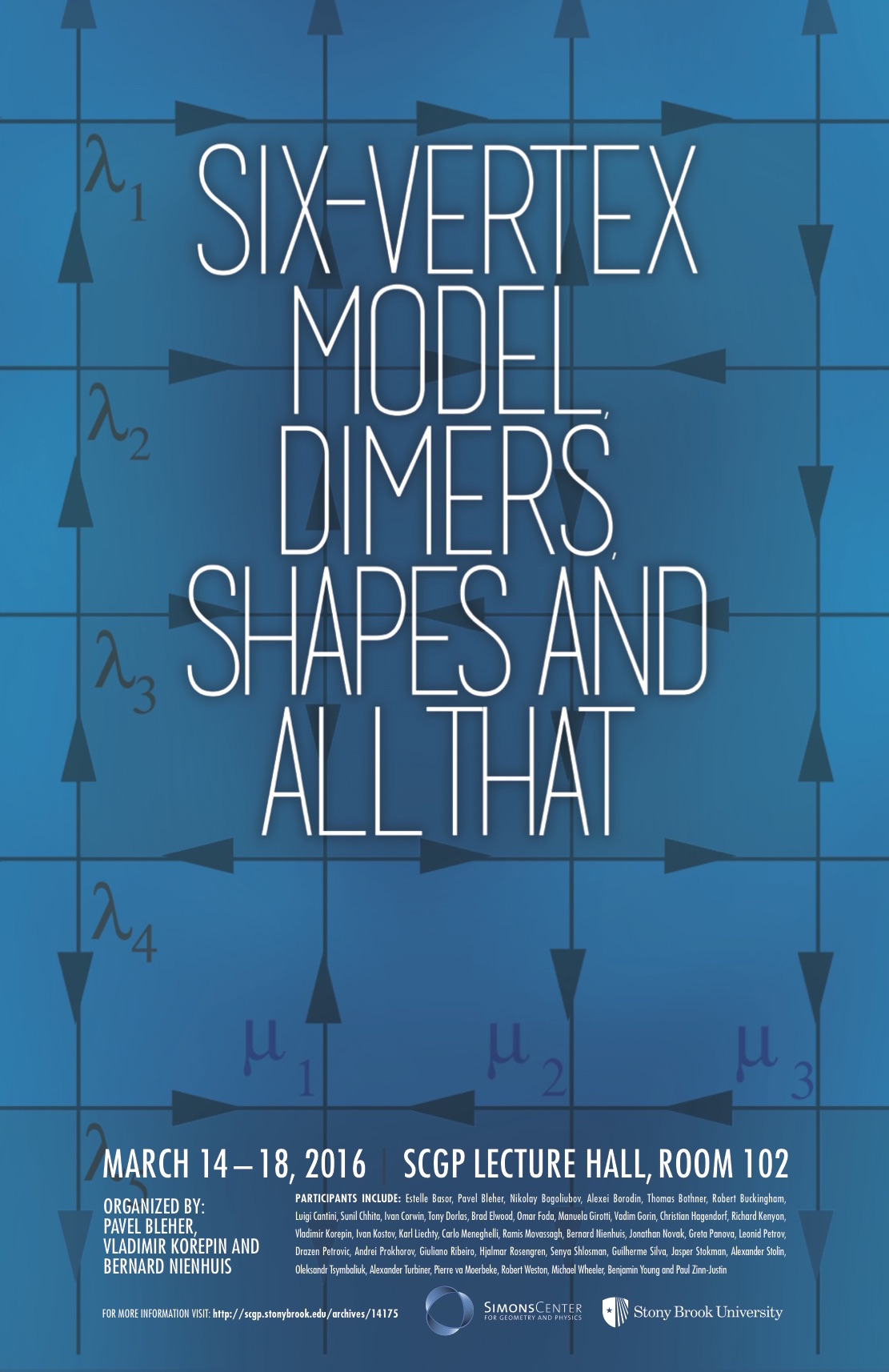Statistical mechanics and combinatorics
Organized by Pavel Bleher, Vladimir Korepin, and Bernard Nienhuis
February 15 – April 15, 2016
The purpose of the program is to relate physics and mathematics, and more specifically, statistical mechanics, algebraic combinatorics, and random matrices. The program will focus on the six-vertex model of statistical mechanics and related models, such as the XXZ spin chain, and loop models. The six-vertex model was introduced by Pauling in 1935mas a two dimensional version of a model for the hydrogen bonds in ice.
The bulk free energy and entropy in the six-vertex model were explicitly calculated for periodic boundary conditions by Lieb. Then other boundary conditions were studied. A very interesting case is the domain wallboundary conditions (DWBC). The six-vertex model provides an important ‘counterexample’ in statistical mechanics: the bulk free energy in the thermodynamic limit depends on boundary conditions. In particular, it is different for periodic and domain wall boundary conditions.
The partition function of the six-vertex model with DWBC in a finite box has been expressed, via the Yang-Baxter equations, in terms of a Hankel determinant. It can be furthermore expressed as a partition function of an ensemble of random matrices with a non-polynomial interaction. This expression was used via the powerful Riemann-Hilbert approach, the asymptotic behavior of the partition function of the six-vertex model with DWBC in different phase regions.
A remarkable observation was made by Razumov and Stroganov that concerns the six-vertex model at a special value of the parameter Delta=1/2, on afinite square grid, transformed into a loop model, i.e. a model of paths on the lattice that can end only on the boundary. In this case the paths visit all vertices exactly once, and all possible configurations are equally probable. This simple measure induces a probability measure on how the edges on the boundary are pairwise connected to each other. This is compared with another loop model placed on a half-infinite cylinder. In this case it is a loop model where the paths pass every edge once, every vertex twice and do not intersect. An equivalent six-vertex model has Delta=-1/2. Again every configuration is equally probable, and again this induces a probability measure on a pairing of the boundary edges. The observation of Razumov and Stroganov is that both probability measures of pairings of boundary edges are the same.
This observation was later proven by Cantini and Sportiello. The original observation has many generalizations on different geometries, but these have not been proven.
The six-vertex model with DWBC relates statistical mechanics to various problems of combinatorics: the statistics of alternating sign matrices, domino tilings, limiting shapes, nonintersecting lattice paths, loop models, and others. Limiting shape formulae in the six-vertex model were proposed recently. The six-vertex model has various generalizations to the eight-vertex model, higher-spin systems, coloring of a lattice, and others, which are important for applications. We plan on inviting leading experts, both physicists and mathematicians, workingon the combinatorics of six-vertex model and its generalizations.
All program talks are held in SCGP Seminar Room 313.
Talk Schedule
| Date & Time | Speaker | Title |
| 2/15 at 2pm | Fabio Franchini | Spontaneous ergodicity breaking in invariant matrix models |
| 2/19 at 1pm | Bernard Nienhuis | Polynomial qKZ equations for loop models |
| Date & Time | Speaker | Title |
| 2/22 at 2pm | Ramis Movassagh | A New Class of Exactly Solvable Quantum Spin Chain models |
| 2/22 at 1pm | Nikolay Bogoliubov | Random walks, plan partitions and correlation functions of Heisenberg chain in the limiting cases |
| Date & Time | Speaker | Title |
| 2/29 at 2pm | Alexei Tsvelik | SU(2n) -invariant spin ladder as a perturbed integrable theory |
| 3/4 at 1pm | Gernot Akemann | Products of random matrices – exact solution and universality |
| Date & Time | Speaker | Title |
| 3/7 at 2pm | Senya Shlosman | Roughening and ballistic transitions in the interacting dimers |
| 3/9 at 10:30am | Soichi Okada | Pfaffian identities and Schur’s Q-functions |
| 3/11 at 1pm | Barry McCoy | The Once and Future Ising Model |
| Date & Time | Speaker | Title |
| 3/21 at 2pm | Robert Shrock | Some Results on Chromatic and Potts/Tutte Polynomials including Zeros and Asymptotic Limits for Families of Graphs |
| 3/25 at 1pm | Pavel Bleher | The mother body phase transition in the normal random matrix model |
| Date & Time | Speaker | Title |
| 3/28 at 2pm | Ivan Kostov | Izergin-Korepin determinant, clustering and Sutherland limit |
| 4/1 at 1pm | Olof Salberger | Shor—Movassagh Model at Half Integer Spins |
| Date & Time | Speaker | Title |
| 4/4 at 2pm | Vassily Gorbunov, U Aberdeen, Scotland | Hidden symmetries in equivariant cohomology related to quantum groups |
| 4/8 at 1pm | Jean-Bernard Zuber, U Pierre Marie Curie, Paris 6, France | Counting curves and knots and links |
| Date & Time | Speaker | Title |
| 4/11 at 2pm | Jacopo Viti | Inhomogeneous quenches and arctic curves in fermionic systems. |
| 4/15 at 1pm | Vladimir Korepin | Statistical Mechanics and Combinatorics |
| 4/15 at 2pm | Tzu-Chieh Wei | Density of Yang-Lee zeros in the thermodynamic limit from tensor network methods |


